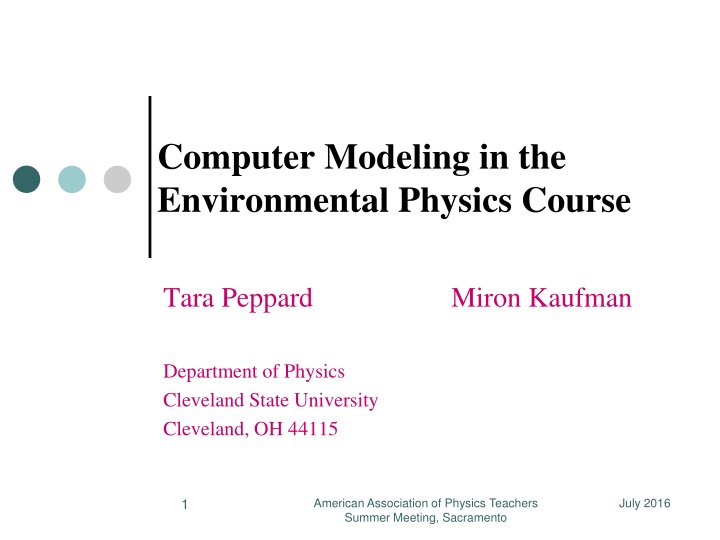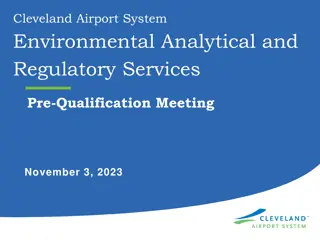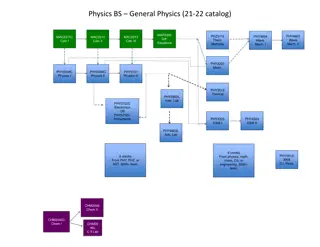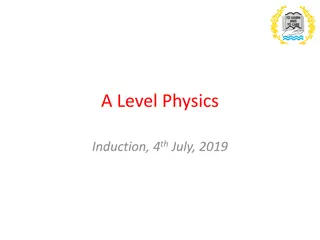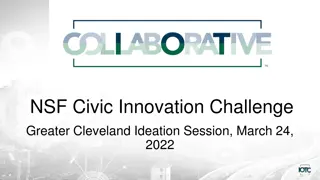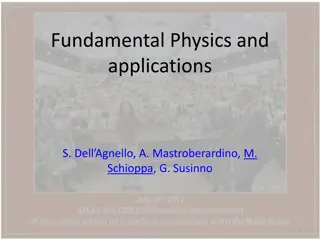Computer Modeling in Environmental Physics Course at Cleveland State University
Since 1996, Cleveland State University has offered a course focusing on Environmental Physics, teaching physical laws behind environmental and sustainability issues. The students, with diverse backgrounds, explore topics such as global climate change, urban heat island, and energy systems through algebra-based curriculum supplemented by extensive computer modeling. The course aims to enhance understanding and develop practical skills in data analysis.
Download Presentation

Please find below an Image/Link to download the presentation.
The content on the website is provided AS IS for your information and personal use only. It may not be sold, licensed, or shared on other websites without obtaining consent from the author.If you encounter any issues during the download, it is possible that the publisher has removed the file from their server.
You are allowed to download the files provided on this website for personal or commercial use, subject to the condition that they are used lawfully. All files are the property of their respective owners.
The content on the website is provided AS IS for your information and personal use only. It may not be sold, licensed, or shared on other websites without obtaining consent from the author.
E N D
Presentation Transcript
Computer Modeling in the Environmental Physics Course Tara Peppard Miron Kaufman Department of Physics Cleveland State University Cleveland, OH 44115 1 American Association of Physics Teachers Summer Meeting, Sacramento July 2016
Abstract Since 1996 we have been offering at Cleveland State University a course entitled Environmental Physics. The goal of the course is to teach the physical laws underlying environmental and sustainability issues. Students have a variety of backgrounds: physics, engineering, urban studies, law and education. They cooperatively learn about global climate change, urban heat island, heat pollution, radiation and health, and conventional versus nuclear energy. The course, by necessity, is algebra-based. To compensate, we use computer modeling extensively. It enhances the understanding of the phenomena through visualizations, and it teaches students useful skills such as data analysis. 2 American Association of Physics Teachers Summer Meeting, Sacramento July 2016
Who Takes Environmental Physics Required for the environmental science, engineering, urban studies, law and for STEM teacher education programs (CSUTeach). Elective course in physics major. Offered twice each year, during each Fall & Spring semester. Enrollment 40 students. Prerequisites: College Physics I (algebra-based mechanics), or University Physics I (calculus-based mechanics) Course description:. Topics include energy and entropy laws; electromagnetic radiation; forms of energy, including fuels, nuclear, solar; percolation model; chaos theory, including population dynamics, and climate. It involves computer simulations. American Association of Physics Teachers Summer Meeting, Sacramento July 2016 3
Multidisciplinary Context Middle ground for students: science: environmental science, physics engineering urban studies, law education 4 American Association of Physics Teachers Summer Meeting, Sacramento July 2016
Materials Textbook: Energy, Physics, and the Environment, McFarland, Hunt, Campbell-intermediate Environmental Physics Computational Projects for PHY 470/570, Dr. Miron Kaufman 1996, 2001, 2004, 2008 & 2014 PTC Mathcad software, Mathcad 15 American Association of Physics Teachers Summer Meeting, Sacramento July 2016 5
Course Structure & Topics of Study Three modules: Thermodynamics: ~ energy and entropy laws; heat transfer, heat pollution, urban heat island effect Electricity and Magnetism: ~ basics, black body radiation and greenhouse effect, power lines and health Nuclear Physics: ~basics, radioactivity and health, nuclear energy, chain reactions In each module (3-4 weeks) we do: basic physics environmental implications modeling 6 American Association of Physics Teachers Summer Meeting, Sacramento July 2016
Computer Modeling Enhance understanding through simulations and visualizations PTC Mathcad is engineering math software that allows you to perform and analyze complex calculations and simulations. Examples: Models of consumption: exponential and Hubbert Brunt V is l oscillations Blackbody Radiation Pollutant diffusion in the atmosphere; Monte Carlo simulation Radioactive decay; Monte Carlo simulation Chaos theory analyze the period doubling route to chaos prevalent in populations models and butterfly effect American Association of Physics Teachers Summer Meeting, Sacramento July 2016 7
Student Feedback Complex in theory, environmental physics also maintains difficult mathematical systems. These processes can be tough to follow, which is why Mathcad is used to simplify the quantitative process. Mathcad allows students to break down intricate concepts into easy to follow step by step procedures. In order to fully understand the math behind the theory, Mathcad is an essential tool to observe the derivations of the equations being taught. - Student from PHY 470 PHY 221 Spring 2013 PHY 470 Spring 2015 Biology, Major Environmental Science, Minor Graduated May 2016 American Association of Physics Teachers Summer Meeting, Sacramento July 2016 8
Semester Schedule ~Computer Labs in Red WEEK #1 WEEK #2, 3 WEEK #4 WEEK #5 WEEK #6 WEEK #7 WEEK #8 WEEK #9, 10 WEEK #11 WEEK #12 WEEK #13 WEEK #14 WEEK #15 Energy, Power Consumption Models: Exponential, Hubbert Thermodynamics: Energy and Entropy Laws Heat Transfer Fossil Fuel; Heat Pollution, Urban Heat Island Electricity Magnetism Black-Body Radiation, Global Warming Power Lines and Health Radioactivity Nuclear Energy Radiation and Health Modeling: Chaos Theory, Population Dynamics Ch.1 Ch.2, 3 Ch.4 Ch.16 Ch.5 Ch.7 Ch.8 Ch.6 Ch.9 Ch.10 Ch.11 Ch.12 Based on 4 contact hours/week 9 American Association of Physics Teachers Summer Meeting, Sacramento July 2016
Models of Consumption Computer Lab #1: Exponential Model Sources of energy Fossil fuels, wind, hydro, solar, nuclear, geothermal, etc Students gain a strong foundation in the variety of energy units & unit conversions. Example: quads = quadrillion Btu = 1015 Btu (Btu = British thermal unit) 1 quad = 1.055 x 1018J = 1.055 EJ 1 barrel of crude oil = 5.8 x 109J .approximately 1 tonne of crude oil = 4.2 x 1010J .approximately 10 American Association of Physics Teachers Summer Meeting, Sacramento July 2016
Models of Consumption Computer Lab #1: Exponential Model In order to make future predictions of future population and energy consumption, and for calculating how long fossil fuels might last, the mathematics of EXPONENTIAL GROWTH are considered. Data can be found with the US Energy & Information Administration Ex. Annual Energy Review Primary energy exports by source (quadrillion btus) & Updated Data Series 6/26/16 Energy Overview or Energy Consumption per Sector (trillions of btus) http://www.eia.gov/totalenergy/ 11 American Association of Physics Teachers Summer Meeting, Sacramento July 2016
Models of Consumption Computer Lab #1: Exponential Model Computer Lab #1 Tutorial & Exponential Consumption Model Computer Lab #1 PDF 12 American Association of Physics Teachers Summer Meeting, Sacramento July 2016
Models of Consumption Computer Lab #2: Hubbert Model It is not reasonable to expect the production of oil will continue to increase until the moment when all the oil is depleted. As supplies start to dwindle, it is more probable that prices will increase and production will drop. Hence, rather than having production that increases continuously, it is more likely to have a leveling off and a then a decline. 13 American Association of Physics Teachers Summer Meeting, Sacramento July 2016
Models of Consumption Computer Lab #2: Hubbert Model This model was suggested in the 1950s by Dr. M. King Hubbert. Hubbert was a geologist working for Shell Oil in Texas. At the time, his work was given little credence by the petroleum industry, but US domestic oil production followed his predictions very well, with a peak in the mid-1970s and then a decline. (Because of US imports, US consumption has been able to increase.) 14 American Association of Physics Teachers Summer Meeting, Sacramento July 2016
Models of Consumption Computer Lab #2: Hubbert Model Mathematics of the Hubbert Model Graph of production rate of a resource versus time; this rate increases, then levels off and declines in a symmetric way. A convenient mathematical function that follows this pattern is the Gaussian, or normal function. 15 American Association of Physics Teachers Summer Meeting, Sacramento July 2016
Models of Consumption Computer Lab #2: Hubbert Model Computer Lab #2 Hubbert Model of Resource Production Computer Lab #2 PDF 16 American Association of Physics Teachers Summer Meeting, Sacramento July 2016
Model for Earth Temperature CL#4 Blackbody Radiation Blackbody radiation is the physics behind global climate change a topic central to all of humanity, not just physicists. National Geographic video producers share their picks for the week of July 15, 2016: Photo Evidence: Glacier National Park Is Melting Away American Association of Physics Teachers Summer Meeting, Sacramento 17 July 2016
Model for Earth Temperature CL#4 Blackbody Radiation 18 American Association of Physics Teachers Summer Meeting, Sacramento July 2016
Model for Earth Temperature CL#4 Blackbody Radiation Actual mean temperature of Earth is 288K = +15 C. The discrepancy of - 12% is due to the role of greenhouse gases in the atmosphere. CO2, CH4, CFC, O3, N2O absorb infrared radiation and sends it back to Earth does heating up the Earth.
Spectral Energy Density Max Planck (1900) discovered the energy is quantized in connection with the radiation problem: spectrum of radiation emitted by a hot object of temperature T. Total intensity is I = T4 and Wien law: mT= 2.898K*mm 3 107 1 1014 7 7 4 10 7 10 8 1013 2 107 6 1013 I 288 ( ) I 5762 ( ) I 252 ( ) 4 1013 1 107 2 1013 7 6 6 6 5 10 1 10 1.5 10 2 10 0 5 5 1 10 2 10 0 Earth emits mostly infrared radiation. Sun emits mostly visible radiation. 20 American Association of Physics Teachers Summer Meeting, Sacramento July 2016
Light Spectrum http://imagine.gsfc.nasa.gov/science/toolbox/emspectrum1.html 21 July 2016 American Association of Physics Teachers Summer Meeting, Sacramento
Model for Earth Temperature ~CL#4 Blackbody Radiation Computer Lab #4 Blackbody Radiation Computer Lab #4 PDF 22 American Association of Physics Teachers Summer Meeting, Sacramento July 2016
Final Thoughts & Acknowledgements Constant updating is necessary, for example: hydofracturing: uses lots of water, chemicals, contamination of aquifers; refining models- Physics Today: Marder, Michael, Patzek, Tadeusz, and Tinker, Scott W. Physics, Fracking, Fuel and the Future." Physics Today July 2016: 46-52. Print. update to computer software Mathcad 15 to Mathcad Prime Effectively teaching students who have less than adequate preparation in calculus and introductory physics. Quantifying the effect of computer modeling with improved understanding. With gratitude to: Dr. Petru Fodor, Physics Department, Cleveland State University, who has provided vast contributions to the development of this course and presentation. He continues to empower and inspire a broad spectrum of students. The Department of Physics and the College of Sciences & Health Professions, Cleveland State University for generously funding the opportunity to share this presentation. American Association of Physics Teachers Summer Meeting, Sacramento 23 July 2016
Other Computer Labs 24 American Association of Physics Teachers Summer Meeting, Philadelphia July 2012
Atmospheric Air Movement Computer Lab #3: Brunt V is l oscillations Buoyancy ' = Weight Vg = = 1 a g Buoyancy ' Vg , T, V , T T P M R T = = 1 a g ( ) T Weight ' T - acceleration of the parcel 24 American Association of Physics Teachers Summer Meeting, Sacramento July 2016
Atmospheric Air Movement ~ Computer Lab #3: Brunt V is l Oscillations https://youtu.be/rOdRbUQzajo 25 American Association of Physics Teachers Summer Meeting, Sacramento July 2016
Atmospheric Air Movement ~ Computer Lab #3: Brunt V is l Oscillations Computer Lab #3 Brunt-V is l Oscillations Computer Lab #3 PDF 26 American Association of Physics Teachers Summer Meeting, Sacramento July 2016
Radioactivity Computer Lab #6: Radioactivity We revisit the exponential model when we discuss radioactivity ~ Exponential Decay Introduction of Monte Carlo simulations useful for modeling complex physical systems a formula that models random movement The incorporation of probability into analysis. We examine the world as a system model the occurrences in a comprehensive way. 27 American Association of Physics Teachers Summer Meeting, Sacramento July 2016
Radioactivity Computer Lab #6: Radioactivity Computer Lab #6 Radioactivity Computer Lab #6 PDF 28 American Association of Physics Teachers Summer Meeting, Sacramento July 2016
